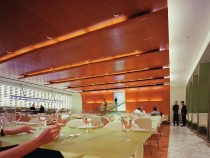
© Michael Moran Photography
As part of the interior design and fitting out of Ludwig Mies van der Rohe’s Seagram Building (1954–58), Philip Johnson created the Four Seasons restaurant and a brasserie. The latter was destroyed by fire five years ago and has now been redesigned by Diller and Scorfidio. Among the dominant spatial features of the new brasserie are the specially shaped pearwood elements and the glass staircase that links the foyer with the actual dining room. The staircase slices through the curved lining to the end wall, dramatizing the entry of visitors, as if they were coming onstage. Along the side wall of the restaurant to the left of the stairs is a series of dining recesses. On the opposite side is the bar, the rear wall of which is designed as a room-height illuminated hollow space in which the various drinks are displayed. The construction consists of a fascia of sliding, translucent-glass doors, behind which individual bottle-holders are fixed to rear-lighted translucent panels. Situated behind the bar is a smaller separate restaurant area. The atmosphere of the brasserie is determined by the elements with which it is fitted out. Their curved forms help to relieve the sober, rectilinear quality of the space, transforming its cross-section into a kind of looping line. The inclined wall-elements flow into the bentwood surfaces of the seating, and at the top, they curve up to meet the lapped soffit elements. The timber strip flooring also curves visibly up-wards at the edges to merge with the wall-elements.









